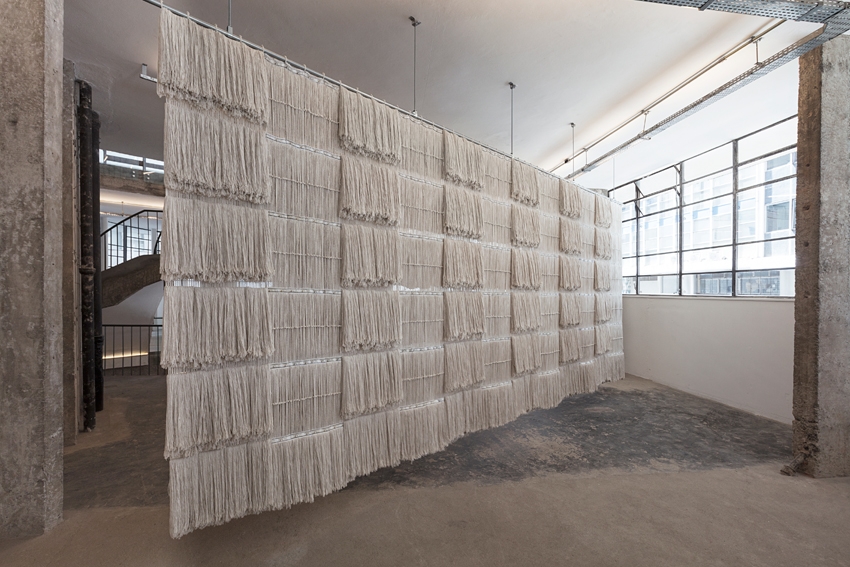Pivô, São Paulo 1 April – 10 June
While its onomatopoeic title suggests that Alexandre da Cunha’s show will offer something in the way of percussive explosions, the mostly monochromatic works gathered in Boom offer a prevailing sense of quietness instead. The exhibition also reveals these works’ intimate relationship with the gallery’s brutalist architecture: canvases made of white wool and fragments of towel and carpet (such as Garden Court, 2016) often almost hide within the space; other works, such as the trailer of a cement-mixing truck that the artist has sliced into four pieces and arranged in different angles (Mix (Boom), 2017), assert themselves by restricting the viewer’s path through the show.
Though such mixers are a common enough sight in São Paulo – given the abundance of construction – this one, dissected, seems alien. At first glance, one is distracted by the helical plates in the interior structure of each element, or by the intriguing black and red stripes over the surface, reminiscent of Kazimir Malevich’s black-and-red crossing paintings (though this is, in actual fact, the mixer’s original paintwork). Yet as soon as we grasp the origin of these strange objects, the work feels at home in Pivô, located in Oscar Niemeyer’s modernist landmark, Edifício Copan, the largest reinforced-concrete building in the country – even if that relationship might seem a little too literal.
In da Cunha’s artistic output, form matters. The textile installation Kentucky (Biombo) (2017), for example, is constructed from mop heads that are almost unidentifiable when stretched and woven together and hung from the ceiling.
Moreover, da Cunha has referred to himself primarily as a ‘collector’ of ordinary objects – among them the mops (a material the artist has used previously) – and this model of working is apparent too in the video Contratempo (2013): a series of more than 300 found still-images of explosions – often but not always nuclear-weapons tests – edited together as a looped montage. Its title, which both suggests the music’s displacement of regular metrical accent by stressing the weak beat, but also an unpredicted or inopportune situation, is similarly a subtly clever way to refer to these horrible events.
In Contratempo, any sense of a documentary index is eliminated, inviting the viewer to see these images on a purely aesthetic level, disassociated from place and context. As such, da Cunha seems to apply the same methodology used in the production of his sculptures. Although the reduction of these destructive events to an exclusively formalist view could be problematic, the video plays a significant role in reinforcing the conflict between silence and noise, restraint and explosion that runs through the works here. This reading is reasserted by Straight-Jacket (2002), made from windsurf-sail material, displayed at the exhibition’s entrance. Along with the video, this work continues to assert a relationship between movements of constraint and release – a very materialistic principle that seems to be behind most of the objects da Cunha reconfigures. Even if a work such as Contratempo can be read from a political perspective – a likely reference to Brazil’s economic boom and social progress that has suddenly failed years later, for example – these messages are not as strong as the artist’s clever formal experiments in appropriation. This is no Greenbergian formalism, however: rather than obsess about the originality or autonomy of the object, da Cunha is blurring the border of art and life and our own perception of these items in accordance to where they are seen and circulated – which is very far from being a formalist idea. As a social critique, the message of this process can also be noisy enough.
From the May 2017 issue of ArtReview
